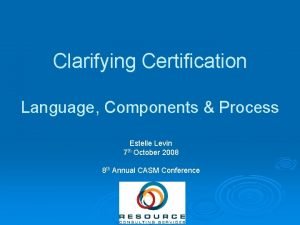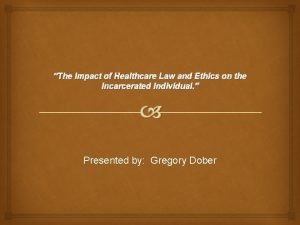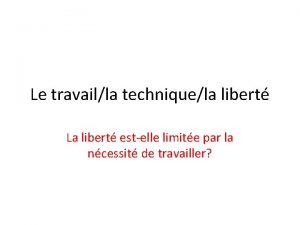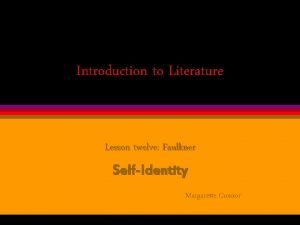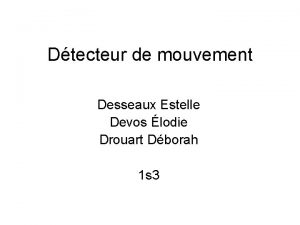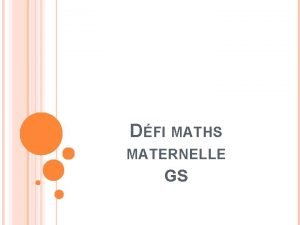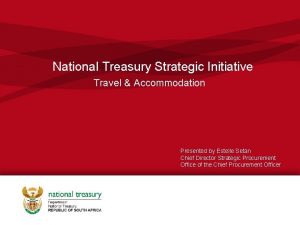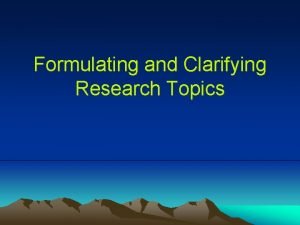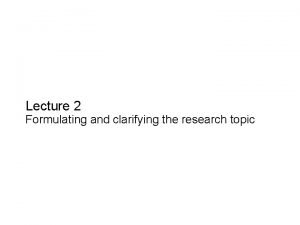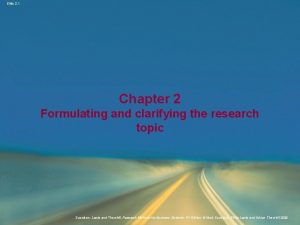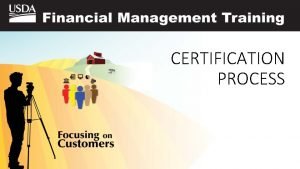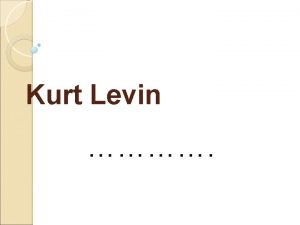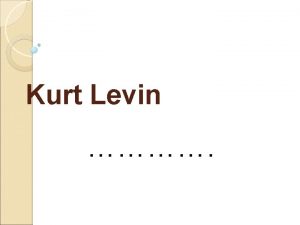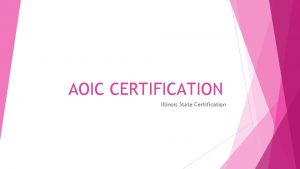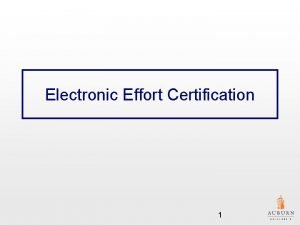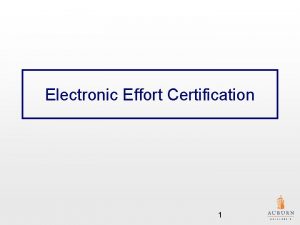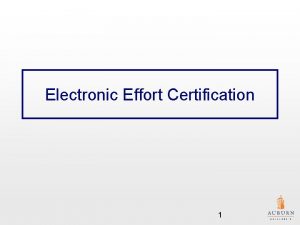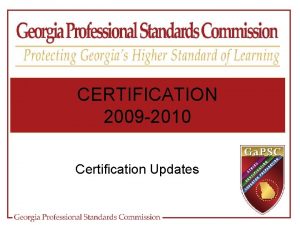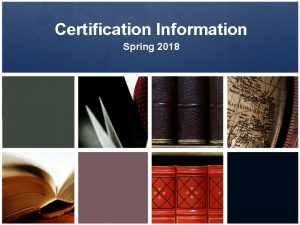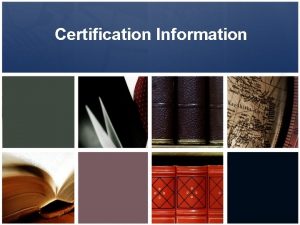Clarifying Certification Language Components Process Estelle Levin 7
















- Slides: 16

Clarifying Certification Language, Components & Process Estelle Levin 7 th October 2008 8 th Annual CASM Conference

Presentation Content Ø Ø Ø Ø A very short history of certification What is certification? Different types of certification Language and definitions Certification fundamentals How to set up a certification system Who is setting up certification for ASM?

A Very Short History of Certification! Neoliberal Structural Adjustment Deregulation Damage to vulnerable people and the commons (the environment, indigenous cultures) NGO Campaigns Consumer Pressure Alternative models of governance and assurance (e. g. certification, corporate social responsibility)

Different types of Assurance Principle modes of governance for assuring social and environmental protection: SYSTEM OWNER DRIVER 1. Government Regulations Government Elections Protect political position 2. Corporate Social & Environmental Responsibility Corporation Brand / risk management Profit Protect access to resources (land, capital, labour) 3. Voluntary Certification Systems Multiple Stakeholders Protect the commons (environment, cultural diversity) and vulnerable populations. CERTIFICATION IS NOT THE ONLY OPTION and may not be the best one! IT DEPENDS ON YOUR OBJECTIVES!

Key Questions for Deciding on Certification as the right Governance Tool What are the project’s objectives? Is the goal to protect the commons or something else? How important is third party assurance? Would first or second-party suffice? Therefore…. Is certification the best way to achieve these goals? Or are there other assurance systems that would achieve these more cheaply? easily? quickly? effectively?

Level of Independence in Assurance Level of independence First party The assessment is conducted by: The person or organisation that is undergoing evaluation. A first party audit includes internal audits or peer reviews. e. g. Company CSR Manager Second Party A person or body that is related to, or has an interest in the person or organisation being evaluated, such as a client or purchaser of products from the organisation. e. g. Buyer, Trade Association Third Party A person or body that is independent of the person or organisation being evaluated, and of user interests in that person or organisation. Certification and accreditation bodies most often carry out third party audits. e. g. FLO-Cert Based on ISEAL (2007, Module 1: 24)

What is Certification? Certification is ONE TYPE OF ASSURANCE. The PURPOSE of certification of artisanal minerals or producers is to: 1. 2. Provide the structure and procedures to achieve specific commercial or developmental goals. Assure the consumer of some type of quality, i. e. that certain goals have been met. It is a PROMISE or GUARANTEE that a particular governance system has been applied and specific standards have been achieved

Different types of Certification can assure 4 main things: 1. 2. 3. 4. Product / manufacturing quality Management systems Origin / chain of custody Process & Production Methods A system which assures all of these things provides total quality or ethical assurance

Type of Certification What is Certified? Useful questions Product quality Naturalness or quality What is the purity of the gold? of manufacture Has the gem been heat treated? Is the diamond synthetic? Examples • Assaying gold • Checking gems for irradiation Management systems How the organisation manages its risks and opportunities How the organisation is run Is there an environmental management plan? Is there an accident & emergency plan? What is the mine security strategy? How comprehensive / effective / feasible are these plans and strategies? Are they properly implemented? Are governance structures democratic and transparent? • ISO 14001 • ISO 9001 • SA 8000 Origin / chain of custody Where the product comes from (origin) Where does the product come from? Who has owned and traded the product? • KPCS • ICGLR Process & Production Methods Social and Are children involved in extraction or environmental issues processing? What do they do? relating to HOW Is mercury used to extract the gold? something is produced Do women have equal access to (mined, farmed, opportunities in the mine? fished, processed) • Fair Trade • Forest Stewardship Council

Language & Definitions 1 Ø Normative Document can be a Standard, Code of practice, Technical Ø Standard Specification and Regulation. l l l Provides the rules, guidelines or characteristics. Sets out the Objectives, Scope, Principles, Requirements / Criteria, and Indicators May also deal with terminology, symbols, packaging, marking or labelling requirements. Ø Principles are the values and goals, which guide how a Standard is drafted, Ø Criteria or Requirements implemented and used for auditing purposes. These are a statement of intent. l l l Derived from the principles. Used to judge the organisation or product’s compliance with the standard. Audited against using pre-determined indicators.

Language & Definitions 2 Ø Conformity Assessment l l Ø Verification l l Ø An assessor or inspector verifies that requirements of a standard have been fulfilled. Verification results are used to decide certification or accreditation. Certification l l Ø Is the assessment of conformity with a standard. Encompasses verification, certification, and accreditation. A decision on certification is taken based on information provided by the inspector or assessor who conducted verification. Third-party attestation that fulfilment of specified requirements has been demonstrated. Accreditation l Third-party attestation of a certification body’s competence to carry out specific conformity assessment tasks.

Certification Fundamentals The following need to be identified or decided upon: The Compliance Mechanism Ø Purpose / Objectives Ø Needs Assessment / Feasibility Ø The Compliance Assessment Monitoring Study Ø l l Ø l Product l l Ø Stakeholders Ø Consultation Process Ø Normative Documents Ø Policies and Procedures Ø Governance framework Verification Certification Accreditation The Assessment Cycle Ø Labelling Ø Financial Structure Ø Capacity-building Ø Traceability & supply chain integrity Ø Cultural prerequisites for good governance

Key objectives in how a Certification System is developed Simple! Ø Productive (i. e. it must realise its objectives), Ø Financially independent Ø Financially sustainable over time Ø Legitimate amongst key stakeholders Ø Applicable in a variety of contexts (universalism). (or the principles may be universals but the requirements etc. can be specific to certain producers and countries ) Ø

ISEAL Certification Development Process (based on Code of Practice) 1. 2. 3. 4. 5. 6. 7. 8. 9. Document procedures for the process (TOR) and justification for the certification system Consult on TOR Develop first draft of Standard Publish the work programme at least once every 6 months, including contact point Conduct public review (consultation) Compile comments received Re-draft Standard, work programme etc. Publish the standard Repeat 4 to 7 Other core aspects: Ø Consensus record-keeping Ø Regular review (every 5 years) Ø Provide a focal point Ø Manage how requirements are presented

Minerals Certification Initiatives Ø CTC - Certified Trading Chains Ø ARM - Association for Responsible Mining Ø KPCS - Kimberley Process Certification System Ø ICGLR - International Conference on the Great Lakes Region Ø CRJP - Council for Responsible Jewellery Practices Ø IRMA - Initiative for Responsible Mining Assurance Ø Various diamonds efforts

Thank you! Estelle Levin Resource Consulting Services, Limited estellelevin@resourceglobal. co. uk +44 1223 241042
 Estelle levin
Estelle levin Estelle v. gamble
Estelle v. gamble Estelle v. gamble
Estelle v. gamble Estelle millet
Estelle millet Estelle libert
Estelle libert Estelle pagnol
Estelle pagnol Estelle oldham jill faulkner
Estelle oldham jill faulkner Estelle devos
Estelle devos Estelle malaquin
Estelle malaquin Estelle setan national treasury
Estelle setan national treasury Clarifying roles and responsibilities
Clarifying roles and responsibilities Spellers clarifying phrase
Spellers clarifying phrase A clarifying listener
A clarifying listener General question in research
General question in research Secondary research question
Secondary research question Formulating and clarifying the research topic
Formulating and clarifying the research topic Formulating and clarifying the research topic
Formulating and clarifying the research topic
